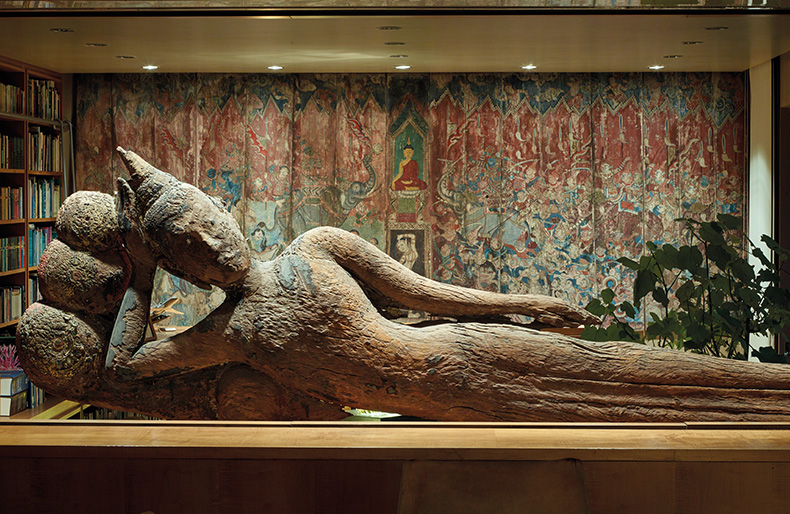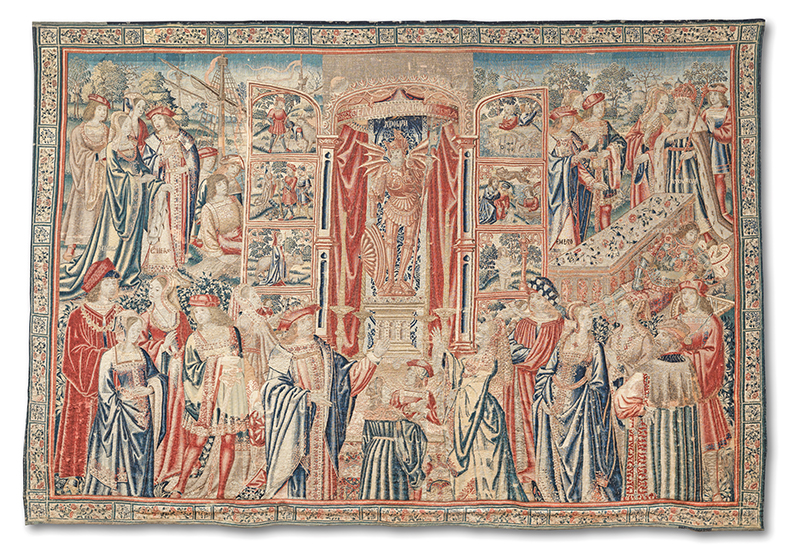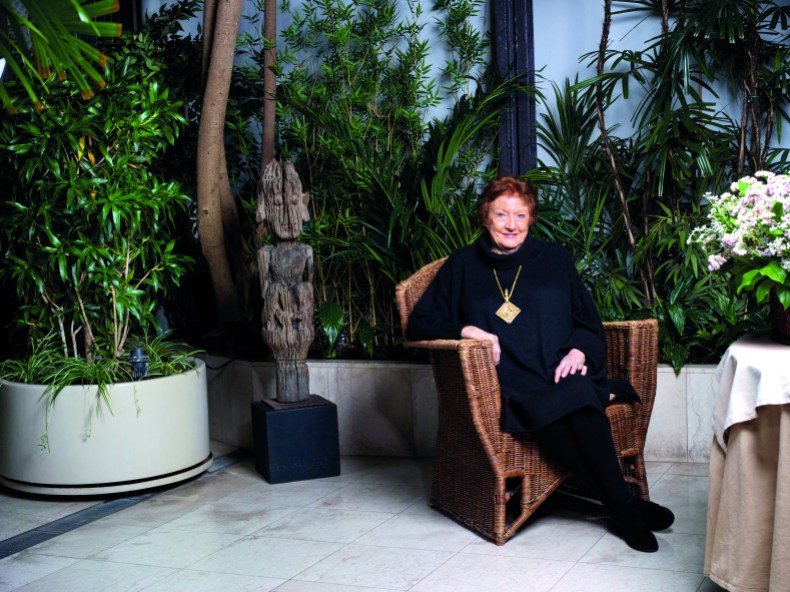From the March 2024 issue of Apollo. Preview and subscribe here.
Helen, Lady Hamlyn CBE is, among many other things, a collector of buildings. More precisely, a collector of remarkable buildings – houses, chateaux, forts and palaces that tend to be either radically new or exceedingly old. ‘It breaks my heart to see a really wonderful building in a state of disrepair,’ she confesses as she describes some of her myriad rescue projects. Several have involved ruins on the brink of collapse. All have not only been carefully coaxed back to life but also, if domestic spaces, gloriously rehabilitated by the addition of works of art.
Yet Hamlyn does not regard herself as an art collector per se. ‘I only buy for a specific building and a specific place,’ she says. There is no compulsive buying here, nor the presumption that some tempting piece will eventually find a home. ‘I do know exactly what I am looking for and then I go out and find it. If you look, you find,’ she says. Her attitude is hardly a surprise, for Hamlyn is one of the world’s doers rather than dreamers. She has often achieved what others considered impossible. Her charitable trust – a 50th birthday present from her late husband, the publisher Paul Hamlyn – is currently involved in some 32 projects, ranging across medicine, arts and culture, education and welfare. As the philanthropist prepares to celebrate her 90th birthday this month, her energy and commitment seem barely diminished.
Her greeting is warm as she rises to meet me from her perch on the arm of a comfortable chair, taking my hand in both of hers. A fire is blazing, the February rain forgotten, as we settle in to talk houses, art, design and a life well lived. ‘I was always pretty headstrong, I am sorry to say,’ she begins. ‘When you are young, you don’t really appreciate what your parents do for you,’ she adds, evidently musing on her mother who was left a widow when Helen was eight and her sister Margie – the potter Margaret O’Rorke – was four. One of the best things they did was to send their daughters to a progressive coeducational school. St Christopher School, Letchworth obviously got something right: ‘It never occurred to me that there might be limitations attached to being a girl.’
Her school years were, inadvertently, responsible for kindling a passion for old houses. After her knee was smashed by a rounders ball when she was 11, she underwent two operations and long recuperation. The only thing to read in the hospital was Country Life, a magazine known for its articles on historic houses and their contents, the pages preceding them advertising hardly less desirable properties for sale. ‘By the end, I think I had decided that I preferred French chateaux to Elizabethan houses.’
A reclining 17th century Buddha from Ayutthaya in present-day Thailand; behind it is a later painted wood panel from India. Photo: Angela Moore

Her mother, Constance Jones, despatched her daughters to the continent as soon as she could after the end of the war. ‘I was sent to stay with families in France, ostensibly to learn French, which I never have,’ she laughs. ‘I speak bad French quite well.’ What astounded the young Helen were the glamorous women she saw dressed in the fabulous Dior ‘New Look’, costumes with cinched waists and very full skirts. After years of uniforms, restrictions and shortages, these clothes exuded femininity, opulence and opportunity. ‘I learnt in France that if you were bright, you made sure you were pretty, whereas in England if you were bright, you were called a bluestocking, wore glasses and looked serious,’ she says. ‘By the time I was 14, I had decided that I wanted to show that women in Britain could be pretty and intelligent.’ She was already making her own clothes, as she had been taught to do by her mother – needs must in a time of war.
Jones considered herself one of the last suffragettes and expected her daughter to go to university. ‘Mummy was incandescent when I said I wanted to go to art school to study fashion. As far as she was concerned, it was hardly better than going on the streets.’ Star that her mother was, however, she found out that the Royal College of Art (RCA), where Madge Garland was inventing formal fashion education, was the best place to study. After a foundation year, she was allowed on to the post-graduate course aged just 17. Her mother insisted that she stay at the Women’s University Settlement, which enabled the educated young to help women and children in deprived areas of London. There her social conscience was born.
At the RCA, she met the remarkable art historian and textile designer Bernard Nevill. ‘Somehow, we became best friends. He introduced me to colour, to textiles, to a more expansive way of thinking, even though we never liked the same things.’ Unlike the incorrigible magpie Nevill, she favoured ‘clean, simple spaces where you can actually see and enjoy what you have got.’ Hamlyn has always held the RCA dear. Such is her admiration for her alma mater that she later endowed the institution with the Helen Hamlyn Centre for Design and a chair of design.
She had completed her first renovation before graduating: a little mews house off Eaton Square bought by her mother. Her precocity – or pure chutzpah – led her to apply for the role of designer at Cresta Silks when she was 21. The company, founded by Tom Heron in 1929, had employed artists as designers from the first – not least Paul Nash, Graham Sutherland and Heron’s son, Patrick. ‘I was told very firmly that I was far too young. Yet six months later, I was invited back and told that they would give me a try. I was there for 15 years. It was the best job anyone could have had. Not only did I design the clothes, but I also chose the materials, and I learnt a little bit about business.’
That year, she married a young architect, Patrick Guest, and the couple began travelling around Europe. ‘I was always fascinated by very early buildings, and l loved the simplicity and purity of Romanesque churches and early chateaux. They became a sort of obsession. I never thought I would have a chance to do it, but I think my dream was to restore a French chateau.’
Instead, she bought a farmhouse in Gloucestershire – a ruin, of course. ‘I realised then that it was stone that I cared about, so I decided we had to move north.’ Here she found an abandoned farmhouse and asked its owner if she could buy it. The delighted famer sold it for £1,500 with five acres thrown in. She then sought out Mary Bellis, the leading dealer in oak furniture and myriad other early objects, who became something of a mentor.
The first of hundreds of acquisitions of early vernacular oak was a pew end – which she still owns – originally from a church in rural France, marking the transition from the Romanesque to the Gothic. The second was an Elizabethan bed, one of many pieces Bellis had originally supplied to the newspaper tycoon William Randolph Hearst to furnish St Donat’s Castle in the Vale of Glamorgan. Hamlyn bought it on the never-never for £350. They had to take the staircase out to get it upstairs. Guest kept the house – and bed – when the couple parted company a few years later.
Nature abhors a vacuum, and that was filled by The Old House at Whichwood in Warwickshire. Her second husband, Paul Hamlyn, was not enamoured of her beloved medieval house, where nettles once met the thatched roof, and which was cold and damp even after its renovations. ‘I remember walking around the village in tears, saying it was [either] “my new husband or my house”,’ she laughs. Her ingenious strategy was to ask some of his top American publisher friends to come and stay. They loved it, of course, and central heating was duly installed. The Hamlyns later exchanged The Old House for the largely Carolean Edgeworth Manor in Gloucestershire, so that there would be more space for Paul’s two teenaged children.
Tapestry depicting scenes from the life of Aeneas, South Netherlands, c. 1510–20. Photo: courtesy Bonhams

‘Eventually I managed to persuade Paul to come to Burgundy, which was my favourite part of France,’ she continues. In the mid 1980s, they started looking for a chateau she could restore. They alighted on the 13th-century Château de Bagnols, which boasts immense 15thcentury towers and the largest Gothic fireplace in France. ‘Ruin was hardly the word,’ says its former chatelaine. ‘There was no roof. It had 22 rooms with Renaissance and later painted rooms, mostly covered with panelling and wallpaper, and trees growing in the outbuildings.’ It took the architect Tom Wilson and some 400 specialist craftsmen four hard years to restore it under her direction, not least given the complications of its listing as a Monument Historique Classé. In 2006, the achievement was acknowledged by the French government, which conferred upon her a Chevalier de l’ordre des Arts et des Lettres. By then, Bagnols had been turned into a luxury hotel. Helen Hamlyn had scoured Europe and America for its contents – extraordinarily, one tapestry bought in New York turned out to have once hung in the chateau.
It does not take long to realise that all of Hamlyn’s houses, past and present, are characterised by a near absence of paintings. Rather, they reveal her penchant for sculpture, screens and textiles. In the period iterations, almost every wall carries a tapestry, every floor a classic carpet, while beds, chairs and sofas offer an opportunity for historic needlework, velvets or silks. Even after reupholstering on an epic scale, a substantial number of textiles remained: a collection that she recently sold.
Tapestries are a particular passion of Hamlyn’s. One, which once hung at the culmination of the long reception hall at Edgeworth Manor, is a particularly complex mythological and allegorical work featuring scenes from the life of the Trojan hero Aeneas, woven in the Southern Netherlands around 1510–20. At the centre, Aeneas is being shown the temple of Apollo, inside of which stands a sculpture of the armoured god himself. He is shown bearing the wings by which Daedalus escaped from Crete and which he then dedicated to Apollo after his safe arrival in Cumae. The tapestry came from the collection of Baron Gustave de Rothschild at the Château Beychevelle.
The atrium pool with a Roman mosaic in Lady Hamlyn’s former home in the Chilterns, designed by architect Robin Partington

The classical world came to the fore in her 21st-century creation, an extraordinary glass curve of a house sunk beneath a meadow in the Chilterns, created for the Hamlyns by the architect Robin Partington. Its atrium pool held a Roman mosaic of the sea nymph Thetis. ‘I try to make every house of mine feel a different world,’ she says. ‘If you are privileged to have more than one house, why would you want them all to look the same?’
In her London house, tapestries were forsaken for Japanese screens. ‘I think they are unutterably beautiful,’ she says, describing how wonderful it is to wake up in any season to cherry blossom and a bubbling waterfall. In her late twenties, visiting the United States for the first time, she had had a fateful encounter with Japanese art in the Art Institute of Chicago: ‘It knocked me out.’ Later she travelled to Japan and found herself entranced by the spare aesthetic and clean lines of Japanese interiors. She began helping the Parisian dealer Jean-Michel Beurdeley organise international exhibitions of Japanese works of art. When it came to Japanese screens, she was – perhaps inevitably – her own best client. One, a Momoyama period eight-fold screen decorated with calligraphy and 18 figures against a gold background, may be one of a pair representing the Thirty-Six Immortals of Poetry.
Eight-panel screen, Japan, Momoyama period, calligraphy attr. Hon’ami Koetsu, painting attr. Tosa Mitsunori. Photo: Angela Moore

Her interest in Asian art did not stop at screens, nor in Japan. ‘I am very, very interested in representing different cultures through sculpture,’ she continued. ‘They mean far more to me than pictures.’ China prevails here in her London home, represented by the likes of an elegant, greenish-grey limestone figure of a standing Bodhisattva from the Sui dynasty (581–618) and a Jin-Yuan period (1127–1368) head from a large Buddhist figure, bearing traces of its original polychrome. It is placed so it can be seen from almost every angle.
That said, nothing matches the scale of a monumental Buddha, depicted lying down to die under a sal tree. Behind this compelling figure from 17th-century Ayutthaya, Thailand, hangs a much later Indian painted wooden panel. When Hamlyn visited the caves in Ellora and Ajanta during a trip to India, she was astounded to find exactly this Buddhist imagery carved in stone behind a reclining Buddha. The spirituality of such pieces is palpable, and a comfort after the death of her husband in 2001. The weathered ironwood hampatong figures from Borneo that line her conservatory were spirit figures made to protect and honour ancestors. Today, they are regarded by Hamlyn as guardians and friends.
Helen Hamlyn in the conservatory of her London homee beside an ironwood hampatong, an anthropomorphic ancestral or guardian Dayak figure from Borneo. Photo: Angela Moore

India has a special place in Hamlyn’s heart. She describes her first visit as ‘a life-changing experience’. With the help of art historian Shobita Punja, a dear friend and one of her trustees, the Helen Hamlyn Trust has supported many philanthropic projects across the country, not least among them important works to improve the World Heritage Site of Khajuraho, Jaisalmer Fort and the Ahhichatragarh Fort at Nagaur. ‘I fell in love with Nagaur,’ says Hamlyn. ‘I told the Maharaja of Jodhpur that I would help restore the complex provided we had a festival to celebrate, once the work was completed.’ Thus the Sacred Spirit Festival Nagaur was born – it is now an annual event. Helen Hamlyn also took on the 16th-century fort at Reis Magos, Goa’s most important historic fort. A government minister asked her why, as no one would go to see it. ‘We [now] have over 900 visitors every Sunday and hundreds on weekdays,’ she says triumphantly.
Chittoor Kottaram, a royal residence in Kerala, was a personal project, its restoration and refurbishment completed by a generous sprinkling of Indian works of art. After a while, she turned it into a hotel. As Hamlyn remarks, with characteristic generosity: ‘There was no point in me doing it, if nobody else can enjoy it.’
From the March 2024 issue of Apollo. Preview and subscribe here.


